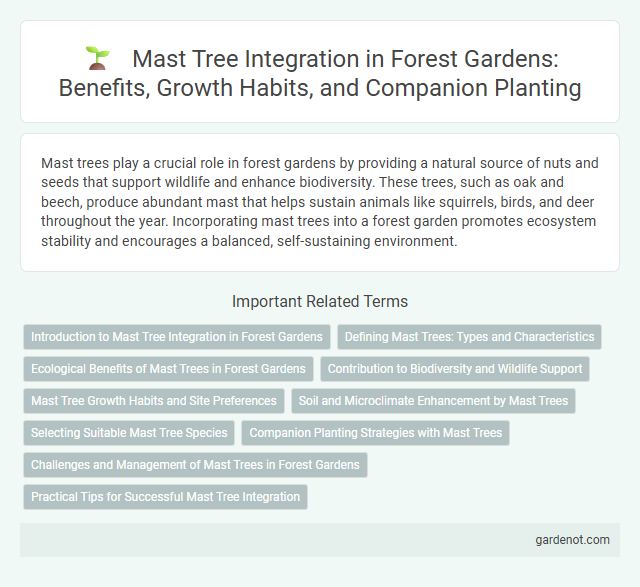Mast trees play a crucial role in forest gardens by providing a natural source of nuts and seeds that support wildlife and enhance biodiversity. These trees, such as oak and beech, produce abundant mast that helps sustain animals like squirrels, birds, and deer throughout the year. Incorporating mast trees into a forest garden promotes ecosystem stability and encourages a balanced, self-sustaining environment.
Introduction to Mast Tree Integration in Forest Gardens
Mast trees, known for producing nuts and seeds like acorns and chestnuts, play a vital role in forest garden ecosystems by providing essential wildlife food sources and enhancing biodiversity. Integrating mast trees supports sustainable forest garden design through natural regeneration, soil enrichment, and multi-layered canopy formation. Selecting species such as oaks (Quercus spp.) and chestnuts (Castanea spp.) ensures effective mast production, contributing to habitat stability and food web support.
Defining Mast Trees: Types and Characteristics
Mast trees produce seeds, nuts, or fruits that serve as crucial food sources for wildlife, classified into hard mast and soft mast types. Hard mast includes large nuts like acorns, chestnuts, and hickory nuts, characterized by their tough shells and high-energy content. Soft mast comprises fleshy fruits such as berries and cherries, providing vital nutrition and supporting diverse forest ecosystems.
Ecological Benefits of Mast Trees in Forest Gardens
Mast trees in forest gardens play a crucial role in supporting biodiversity by providing essential food resources such as nuts and seeds for wildlife, including birds, squirrels, and insects. Their deep root systems enhance soil structure and nutrient cycling, promoting healthier and more resilient ecosystems. By fostering habitat complexity, mast trees contribute to natural pest control and increased pollinator activity, boosting overall forest garden productivity and sustainability.
Contribution to Biodiversity and Wildlife Support
Mast trees produce abundant nuts and seeds that serve as vital food sources for a variety of wildlife, including birds, squirrels, and deer, supporting complex forest food webs. Their dense canopy and structural diversity create essential habitats and nesting sites, enhancing overall biodiversity in forest garden ecosystems. By fostering diverse plant and animal communities, mast trees play a crucial role in maintaining ecological balance and resilience.
Mast Tree Growth Habits and Site Preferences
Mast trees, such as oak and chestnut, exhibit slow to moderate growth habits, thriving in well-drained, fertile soils with full sunlight to partial shade. These trees prefer temperate climates and require ample space for their extensive root systems and broad canopies. Their deep roots enhance soil stability, making them crucial components in forest garden ecosystems for long-term sustainability and wildlife habitat.
Soil and Microclimate Enhancement by Mast Trees
Mast trees significantly improve soil fertility by contributing rich organic matter through leaf litter and decomposing nuts, which enhances nutrient cycling and supports diverse microbial communities. Their dense canopy moderates microclimates by regulating temperature and humidity levels, creating favorable conditions for understory plants and soil organisms. These ecological functions promote a resilient forest garden ecosystem with increased biodiversity and productivity.
Selecting Suitable Mast Tree Species
Selecting suitable mast tree species for a forest garden requires prioritizing native oaks, chestnuts, and hickories known for their abundant nut production and ecological benefits. These species support local wildlife by providing essential food resources and contribute to soil health through deep root systems. Optimal mast tree selection enhances biodiversity, promotes sustainable yields, and ensures long-term forest garden productivity.
Companion Planting Strategies with Mast Trees
Mast trees such as oak, chestnut, and beech serve as foundational species in forest gardens by producing abundant nuts and seeds that enhance biodiversity and soil fertility. Companion planting strategies involve integrating nitrogen-fixing plants like hazelnut and elderberry around mast trees to improve nutrient cycling and support understory crops such as medicinal herbs and berry bushes. This synergy increases resilience against pests, promotes natural regeneration, and maximizes ecosystem productivity within the forest garden system.
Challenges and Management of Mast Trees in Forest Gardens
Mast trees in forest gardens face challenges such as irregular seed production, pest infestations, and competition from invasive species, which can reduce yield and biodiversity. Effective management involves monitoring seed cycles, implementing integrated pest management strategies, and promoting soil health through mulching and organic amendments. Encouraging biodiversity and maintaining structural diversity within the forest garden also enhance mast tree resilience and productivity.
Practical Tips for Successful Mast Tree Integration
Select mast tree species native to your region, such as oaks or beeches, to ensure ecological compatibility and provide abundant nuts and seeds for wildlife. Space trees adequately to allow sunlight penetration and root expansion, preventing competition with understory plants in your forest garden. Implement regular pruning and monitor for pests to maintain tree health and maximize mast production for sustainable food sources and habitat enrichment.
Mast tree Infographic

 gardenot.com
gardenot.com